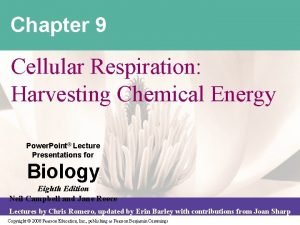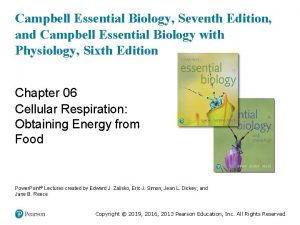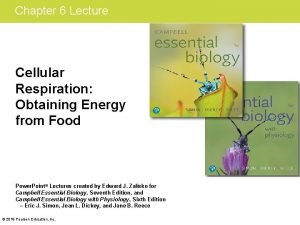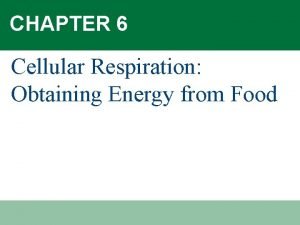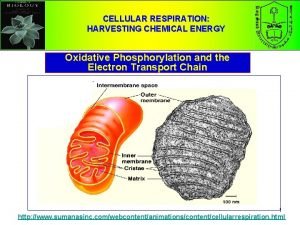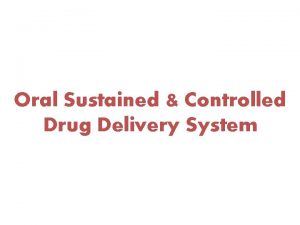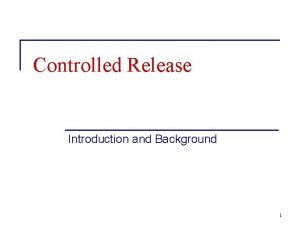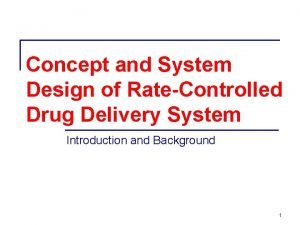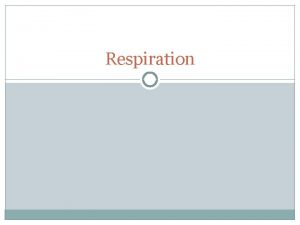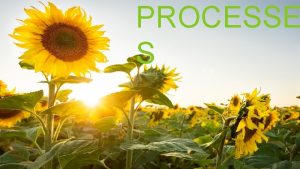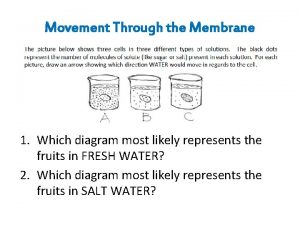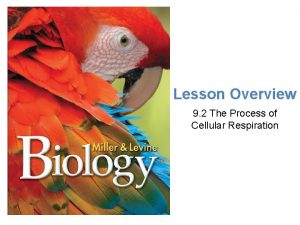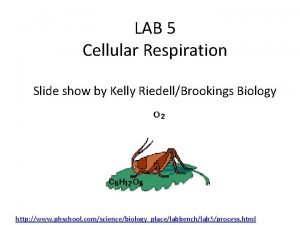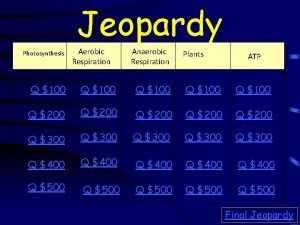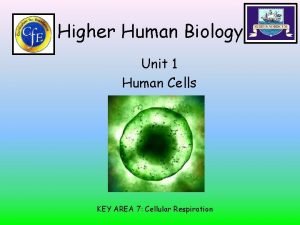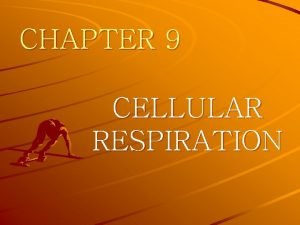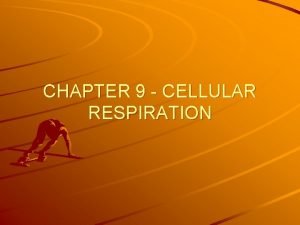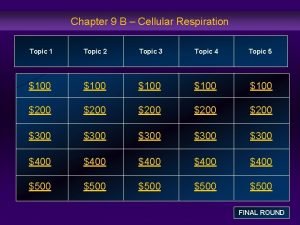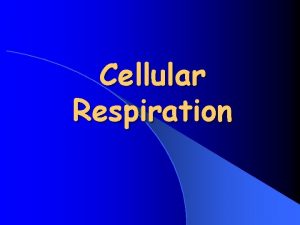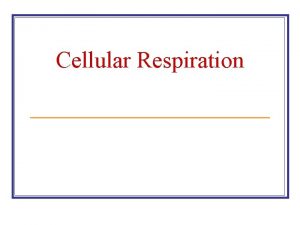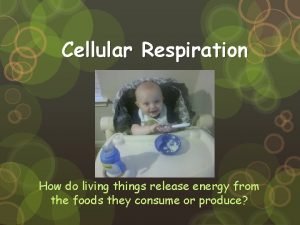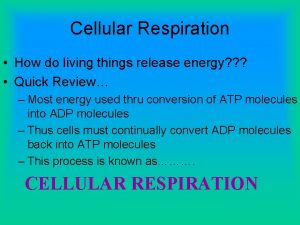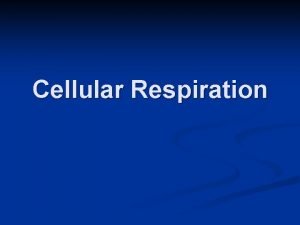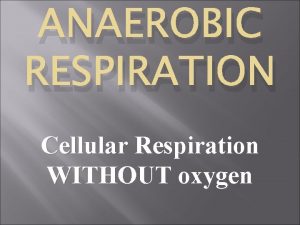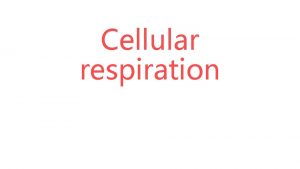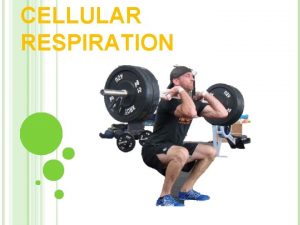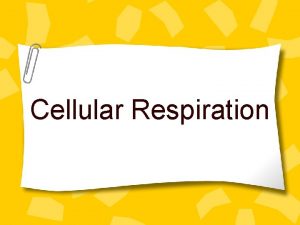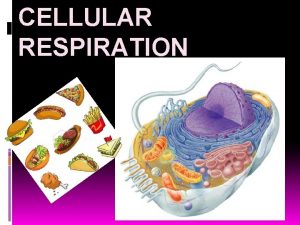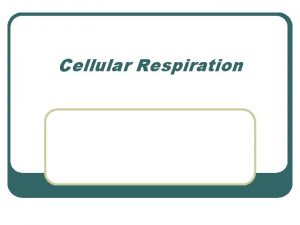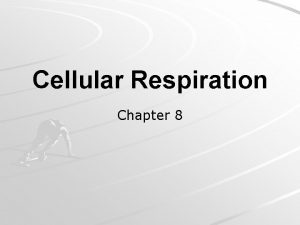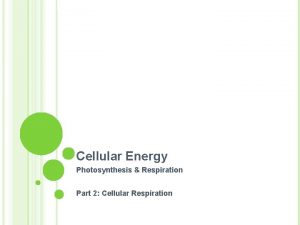Cellular Respiration How do living things release energy





































- Slides: 37

Cellular Respiration • How do living things release energy? ? ? • Quick Review… – Most energy used thru conversion of ATP molecules into ADP molecules – Thus cells must continually convert ADP molecules back into ATP molecules – This process is known as………. CELLULAR RESPIRATION

Lesson Objectives • Name three stages of cellular respiration. • Give an overview of glycolysis. • Explain why glycolysis probably evolved before the other stages of aerobic respiration. • Describe the structure of the mitochondrion and its role in aerobic respiration. • List the steps of the Krebs cycle, and identify its products. • Explain how electron transport results in many molecules of ATP. • Describe how chemiosmotic gradients in mitochondria store energy to produce ATP. • State the possible number of ATP molecules that can result from aerobic respiration. • Define fermentation. • Describe lactic acid fermentation and alcoholic fermentation. • Compare the advantages of aerobic and anaerobic respiration. • Compare cellular respiration to photosynthesis

Breathing versus Cellular Respiration • Breathing: physical process that allows animals and humans to come into contact with gases in the air • Cellular respiration: chemical process that releases energy from organic compounds (food), gradually converting it into energy that is stored in ATP molecules

Correlation between a campfire and Cellular Respiration • Analyzing a campfire can clarify your understanding of cellular respiration. – A campfire breaks chemical bonds in wood, releasing stored energy as light and heat – Cellular respiration breaks chemical bonds in glucose, releasing stored energy and transferring some to 38 ATP; some energy is lost as heat.

Chemical Pathways ☼ Food is the raw material that provides the energy for your body to function ☼ Cells use food to synthesize new molecules to carry out their life processes

• Cells do not BURN glucose, they slowly release energy from it and other food compounds through several pathways (processes) – 1 st pathway glycolysis: releases only a small amount of energy (2 net ATP) • If oxygen present, it will lead to two other pathways that release a lot of energy: Krebs cycle & Electron Transport Chain • If oxygen absent glycolysis is followed by a different pathway: Alcoholic Fermentation or Lactic Acid Fermentation

Overview of Cellular Respiration • In presence of oxygen (aerobic) glycolysis is Krebs Cycle followed by: _______ Electron Transport Chain _______

– All three combined make up Cellular Respiration: Glycolysis + Krebs Cycle + Electron Transport Chain • Process that releases energy by breaking down food molecules in the presence of oxygen Equation for cellular respiration: 6 O 2 + C 6 H 12 O 6 ------- 6 CO 2 + 6 H 2 O + energy (ATP) oxygen + glucose ----- carbon dioxide + water + energy 1 2 3 Each of these 3 stages captures some of the chemical energy available in food molecules and uses it to produce ATP

What is the process of glycolysis? ?

Glycolysis • Process takes place in the cytosol of the cytoplasm outside of mitochondria; coverts glucose with the help of 2 ATP molecules and eventually releases 4 ATP molecules; for a net gain of 2 ATP molecules.


ATP & NADH production in Glycolysis Step 1: breaks 1 molecule of glucose in half, producing 2 molecules of pyruvic acid (a 3 -carbon compound) Step 2: 2 NAD+ ; electron carrier accepts 4 high-energy electrons transfers them to 2 NADH molecules and 2 H+ thus passing the energy stored in the glucose Step 3: 4 ADP added producing 4 ATP Step 4: 2 remaining pyruvic acids enter Krebs Cycle in presence of oxygen; IF no oxygen another pathway is followed NAD+ (nicotinamide adenine dinucleotide) 2 NADH & 2 H+ produced 2 ATP used up become 2 ADP 4 ATP produced Net gain = 2 ATP

• Glycolysis is a fast process • Cells produce thousands of ATP molecules in a few milliseconds • Glycolysis alone DOES NOT require oxygen – It can supply chemical energy to cells when oxygen is NOT available However if a cell generates large amounts of ATP from glycolysis it can run into problems a. the cell’s available NAD+ molecules become filled up with electrons b. glycolysis shuts down, cannot proceed without available NAD+ molecules c. ATP production stops

Anaerobic to Aerobic Respiration • Glycolysis evolved before the other stages of cellular respiration; other stages need oxygen • No oxygen in Earth’s atmosphere when life first evolved about 3. 5 to 4 b. y. a. • Without oxygen anaerobic respiration • 2 or 3 billion years ago, oxygen was gradually added to the atmosphere by early photosynthetic bacteria; period the “oxygen catastrophe” aerobic organisms

Let’s look at the pathway that follows gycolysis with the presence of oxygen…. . aerobic respiration

BUT FIRST…Mitochondrion Structure • Mitochondrion has two separate membranes: inner and outer membrane. • Three compartments: intermembrane space, cristae space, and matrix

AEROBIC RESPIRATION: The Krebs Cycle and Electron Transport • End of glycolysis 90% of chemical energy from glucose still unused, locked in high-energy electrons of pyruvic acid • Extracted by world’s most powerful electron receptor OXYGEN • Krebs and Electron Transport require oxygen thus they are aerobic processes

The Krebs Cycle 1. 2 nd stage of cellular respiration 2. Named after Hans Krebs, British biochemist in 1937 3. Here pyruvic acid is broken down into carbon dioxide in a series of energy-extracting reactions 4. Citric acid is the 1 st compound formed in this series of reactions, so Krebs is sometimes called the Citric or Citric Acid Cycle.

Pyruvic acid enters from glycolysis; One carbon removed = CO 2 formed NAD+ again changed to NADH Co. A joins remaining 2 carbons = Acetyl-Co. A added to 4 carbon Compound = Citric acid (6 -C) Citric acid broken down to 5 -carbon then 4 carbon; more CO 2 released Along the way more NADH and FADH 2 formed One molecule of ATP also made 2 turns & 2 pyruvic acid (from glycolysis) yield: 10 NADH (2 from glycolysis) 2 FADH 2 4 ATP (2 from glycolysis) Cycle starts anew

Uses for the products of the Krebs Cycle • Carbon dioxide is exhaled (waste product) • ATP can be used for cellular activities • High-energy electrons (stored in NADH & FADH 2) can be used to make huge amounts of ATP in the presence of oxygen

1. 2. 3. 4. 5. 6. Electrons from Krebs cycle are passed to electron transport chain by NADH & FADH 2 At end of the chain an enzyme combines electrons from the electron chain with H+ ions and oxygen to form water Each time 2 high-energy electrons transport down the electron chain, their energy is used to transport H+ ions across the membrane H+ ions build up in intermembrane space it is now positively charged, other side of membrane negatively charged (DISPLAY) Electrochemical gradient (chemiosmotic gradient) created for ATP synthase to work (OFF) ATP synthase converts ADP into ATP (DISPLAY)

The Total ATP production of Aerobic CR • How much chemical energy comes from one molecule of glucose? ? – Absence of oxygen: • Only 2 ATP molecules from glycolysis – Presence of oxygen: • 2 net ATP molecules from glycolysis • 36 more ATP molecules from Krebs Cycle and electron transport These 38 ATP molecules represent 38% of the total energy of glucose, remaining 62% is released as heat, thus your body feels warmer after vigorous exercise and does not freeze in winter.

Let’s look at the pathway that follows gycolysis without the presence of oxygen…. . anaerobic respiration

Anaerobic Respiration: Fermentation This occurs after glycolysis when oxygen absent, thus anaerobic process • Fermentation releases energy from food molecules in absence of oxygen – In this process cells convert NADH to NAD+ by passing high-energy electrons back to pyruvic acid – Now glycolysis has NAD+ and can continue producing ATP – There are 2 types of fermentation: • Alcoholic fermentation • Lactic acid fermentation

• Anaerobic and aerobic respiration share the glycolysis pathway. If oxygen is absent, fermentation may take place, producing lactic acid or ethyl alcohol and carbon dioxide. Products of fermentation still contain chemical energy, and are used widely to make foods and fuels.

Alcoholic Fermentation 1. Yeast and a few other microorganisms use alcoholic fermentation, forming ethyl alcohol and carbon dioxide as wastes 2. Equation for alcoholic fermentation: pyruvic acid + NADH ethyl alcohol + CO 2 + NAD+

Lactic Acid Fermentation 1. 2. 4. 5. Many cells convert accumulated pyruvic acid from gycolysis to lactic acid; lactic acid fermentation regenerates NAD+ so glycolysis can continue Equation for lactic acid fermentation: pyruvic acid + NADH lactic acid + NAD+ When your body cannot supply enough oxygen to muscle tissues during exercise, this is produced Without oxygen the body is unable to produce all the ATP it requires, so lactic acid fermentation takes over

Running, swimming, or riding a bike as fast as you can = large muscles in your legs and arms that quickly run out of oxygen…muscles begin to rapidly produce ATP by lactic acid fermentation. The buildup of lactic acid fermentation causes a painful burning sensation making your muscles feel sore… How do you stop it? ? ? NEED TO INTAKE OXYGEN

Energy and Exercise • Initially body uses ATP which is already available in muscles • Then new ATP made by Lactic Acid Fermentation and Cellular Respiration • Eventually energy supply runs out A. Quick Energy 1. ATP in muscles only lasts a few seconds 2. ATP from lactic acid fermentation lasts about 90 seconds - this then creates a by-product (lactic acid) which the body must get rid of, the body releases it by panting heavily (intake of oxygen)

B. Long-Term Energy - exercise lasting longer than 90 seconds utilizes cellular respiration to generate a continuous supply of ATP - cellular respiration releases energy slower than fermentation, thus athletes can pace themselves - body stores energy in muscles and tissues in the form of glycogen (carbohydrate) -- stores of glycogen usually lasts for 15 -20 minutes of activity, then the body starts to break down other molecules like fat for energy HOW LONG DO YOU NEED TO ACTIVE BEFORE YOU START TO BURN FAT? ? ? 17 -22 minutes

Aerobic vs. Anaerobic Respiration: A Comparison • Advantages of Aerobic Respiration • Major advantage more energy released • Enough energy to produce up to 38 ATP • Advantages of Anaerobic Respiration • Lets organisms live in places where there is little or no oxygen • Quickly produces ATP

Relationship between Cellular Respiration and Photosynthesis Equation for Cellular Respiration: 6 O 2 + C 6 H 12 O 6 6 CO 2 + 6 H 2 O + energy (ATP) Equation for Photosynthesis: 6 CO 2 + 6 H 2 O + energy (sunlight) 6 O 2 + C 6 H 12 O 6


LET’S REVIEW… • How many stages does cellular respiration have? ______ 3 • What are the stages of cellular respiration? GLYCOLYSIS, KREBS CYCLE, AND __________________ ELECTRON TRANSPORT CHAIN __________________ • Where does glycolysis take place? CYTOSOL OF THE CYTOPLASM OF MITOCHONDRIA __________________ • Where does the Krebs cycle take place? __________________ IN THE MATRIX OF MITOCHONDRIA

• Where is the Electron Transport Chain located? INNER MEMBRANE OF MITOCHONDRIA _________________ • What do high-energy electrons help the cells build? MOLECULES LIKE GLUCOSE; ATP __________________________________ • What are the stage(s) of aerobic respiration? GLYCOLYSIS, KREBS CYCLE, AND ELECTRON _________________ TRANSPORT CHAIN _________________

• What are the stage(s) of anaerobic respiration? _________________ GLYCOLYSIS, FOLLOWED BY FERMENTATION _________________ • What are the two types of fermentation? ALCOHOLIC FERMENTATION AND _________________ LACTIC ACID FERMENTATION _________________ • Which fermentation process do humans use? LACTIC ACID FERMENTATION _________________

Lesson Summary In the two to three billion years since photosynthesis added oxygen to earth’s atmosphere, life has become mostly aerobic. Some organisms and types of cells retain the older, anaerobic pathways for making ATP; these pathways comprise anaerobic respiration or fermentation. • Muscle cells can continue to produce ATP when O 2 runs low using lactic acid fermentation, but muscle fatigue and pain may result. • Both alcoholic and lactic acid fermentation pathways change pyruvate in order to continue producing ATP by glycolysis. • Aerobic respiration is far more energy-efficient than anaerobic respiration. • Aerobic processes produce up to 38 ATP per glucose. Anaerobic processes yield only 2 ATP per glucose.
 Oxidative phosphorylation enzymes
Oxidative phosphorylation enzymes Inputs of glycolysis
Inputs of glycolysis Energy flow in cellular respiration
Energy flow in cellular respiration Chapter 9 cellular respiration harvesting chemical energy
Chapter 9 cellular respiration harvesting chemical energy Chapter 9: cellular respiration: harvesting chemical energy
Chapter 9: cellular respiration: harvesting chemical energy Cellular respiration obtaining energy from food
Cellular respiration obtaining energy from food Cellular respiration obtaining energy from food
Cellular respiration obtaining energy from food Phosphorelation
Phosphorelation Venn diagram living and nonliving things
Venn diagram living and nonliving things The smallest living unit within the human body is
The smallest living unit within the human body is Time release medication
Time release medication Nocoderm
Nocoderm Extended release vs sustained release
Extended release vs sustained release All living things have seven life processes
All living things have seven life processes Cellular energy section 1 how organisms obtain energy
Cellular energy section 1 how organisms obtain energy Cellular respiration redox
Cellular respiration redox What is the correct equation for cellular respiration?
What is the correct equation for cellular respiration? Cellular respiration steps
Cellular respiration steps Aerobic vs anaerobic
Aerobic vs anaerobic Fementation
Fementation Why is cellular respiration important
Why is cellular respiration important Complementary processes
Complementary processes Cellular respiration chemical equation
Cellular respiration chemical equation Cellular respiration reactants
Cellular respiration reactants Photosynthesis equation.
Photosynthesis equation. Photosynthesis recipe card
Photosynthesis recipe card Electron carriers in cellular respiration
Electron carriers in cellular respiration Overview of cellular respiration
Overview of cellular respiration Overview of respiration
Overview of respiration Overview of cellular respiration
Overview of cellular respiration Total atp produced in cellular respiration
Total atp produced in cellular respiration Lab bench cellular respiration
Lab bench cellular respiration What is the word equation for cellular respiration
What is the word equation for cellular respiration Higher human biology cellular respiration
Higher human biology cellular respiration Chemical equation for cellular respiration
Chemical equation for cellular respiration Products of cellular respiration
Products of cellular respiration Cellular respiration releases
Cellular respiration releases Starting materials for cellular respiration
Starting materials for cellular respiration

